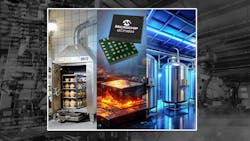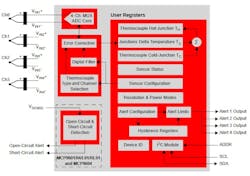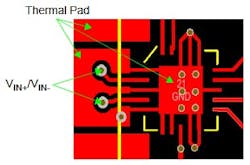Quad-Channel Thermocouple Embeds CJC, Polynomial Linearization
What you'll learn:
- The many available options for temperature-sensing transducers.
- The unique challenges and benefits of using thermocouples for temperature measurement.
- How a new IC greatly simplifies utilizing multiple thermocouples.
Thermocouples are widely used for temperature measurement due to their accuracy, repeatability, precision, physical ruggedness, stability, and wide-ranging temperature capabilities. However, they present an interface challenge: They need amplification of their microvolt/millivolt-level output and cold-junction compensation (CJC). Many applications also need some degree of linearization of their temperature/output-voltage transfer function for acceptable results (see “Thermocouple Perspective” below).
Recognizing these issues, Microchip Technology introduced the MCP9604 integrated thermocouple-conditioning IC that overcomes the thermal-measurement and integration barrier. It’s the first single-chip, four-channel I2C thermocouple conditioning IC to deliver up to ± 1.5°C accuracy.
The IC offers an alternative to discrete and multichip solutions that can introduce errors, add to system design traps, and lengthen the bill of materials (BOM). Due to its high level of integration, the I2C-based physical connection between the thermocouple sensor and the system MCU is trivial (Fig. 1).
But don’t let the simple connection mislead you, as there’s a lot of internal, invisible complexity (Fig. 2).
NIST ITS-99 Equations Drive Higher Accuracy
The MCP9604 executes its advanced measurement accuracy for four thermocouple locations by using higher-order NIST ITS-90 equations for linearization rather than the simplistic single-order linear approximations of earlier all-analog amplifier designs. It does so via a processor core that’s used to compute the EMF to degree Celsius conversion using coefficients derived from the NIST ITS-90 coefficients.
It supports Type K, J, T, N, S, E, B and R thermocouples as defined by the NIST ITS-90 standard. As a performance example, it achieves ninth-order accuracy with K-type thermocouples in one integrated chip by incorporating the analog-to-digital converters (ADCs), CJC temperature sensors, amplifiers, and other components required for the temperature-measurement and math-engine signal chain.
Incorporating Cold-Junction Compensation
Providing cold-junction compensation is often a practical problem for thermocouple systems. The CJC temperature sensor is usually a lower-accuracy, limited-range device (often not a thermocouple). Situated at the connection junction between the thermocouple wires and the “plain-old” system copper wiring, it’s needed to correct for the unavoidable thermocouple created by this junction.
Traditionally, the CJC sensor is located at the connector or barrier strip where the thermocouple and system wires meet (and thus also requires another wire pair for that sensor). What Microchip has done is place the CJC sensor in the MCP9604 package, so there’s no need for a discrete CJC sensor.
The user does have to follow some “best practices” guidelines for running PCB traces to the device — a good PCB layout is key for better thermal conduction from the PCB temperature to the sensor die, but these guidelines are fairly straightforward (Fig. 3).
The PCB provides thermal conduction from the die to the thermocouple cold-junction. Therefore, the component placement positioning and the copper layout techniques are key for optimum cold-junction compensation. The recommended implementation for optimum temperature sensitivity is to extend a copper ground pad around the device pins.
More than Just Accurate Measurement
The temperature converter comes with user-programmable registers to provide design flexibility for various applications. The registers allow for user-selectable settings such as low-power modes for battery-powered applications, adjustable digital filters for fast transient temperatures, and four individually programmable temperature-alert outputs that can be used to detect multiple temperature zones.
In addition, the device (and its single-channel family members) includes open-circuit and short-circuit detection features, where an alert signal is asserted when the thermocouple wire is broken or disconnected. Similarly, an alert signal is asserted when the thermocouple is shorted to ground or power.
The MCP9604 device is supported by a 59-page datasheet and the EV19L27A evaluation board (Fig. 4) with a 24-page user manual and free downloadable software. It can connect to and read information from as many as four thermocouples. A microcontroller acts as a host system for receiving this information and plotting the selected thermocouple.
The MCP9604 thermocouple-conditioning IC is priced at $10.56 each (10,000-unit) and packaged in a 24-pin 5×5 land grid array (LGA). The supporting EV19L27A evaluation board costs $96.00.
Thermocouple Perspective
Temperature is the most widely measured real-world variable for many reasons. As a result, designers have many choices on how to measure it, either by direct contact or indirect assessment. Among the choices for the former are solid-state sensors, thermistors, RTDs, and the classic thermocouple. For the latter, options include pyrometers, IR sensors, and even laser-based arrangements — and these are just a few of what’s out there.
Thermocouples, which are based on the Seebeck effect (discovered in 1821), use two dissimilar metals joined at their tip. They have been used since the mid-1800s, when they were originally called thermoelectric pyrometers.
Studied extensively from materials-science and electromotive-force perspective, thermocouples are available to cover a wide range of operation from cryogenic to over 1000⁰C, among their other virtues. In the early part of the 20th century, the dissimilar-metal pairings were standardized and given “Type-Letter” designations with Type K, J, T, N, S, E, B and R as the common ones.
In addition to their low-voltage output, they have a less-desirable characteristic: highly consistent but nonlinear output voltage versus sensed temperature. Along with the Type-Letter standardization, the National Bureau of Standards (then NBS, renamed NIST—the National Institute of Standards and Technology) did extensive high-accuracy research and experimentation to develop a high-precision table for each type. It showed the relationship between measured output voltage versus temperature (they also quantified the reverse relationship of a given temperature and associated voltage).
NIST also developed high- and higher-order polynomials with specified coefficients that capture this nonlinearity, enabling users to correct it via calculations.
Users who may need linearization have several options for achieving it:
- Do nothing and ignore the nonlinearities, which may be acceptable if the range of measurement is limited or the accuracy requirements are modest.
- Use analog piecewise straight-line linearization with multiple segments. This was traditionally done using op amps with breakpoints, but that’s not an attractive approach given the newer options.
- Implement the piecewise approach, but do it in software.
- Use a detailed lookup table with the needed granularity, which consumes memory but only modest computational resources.
- Implement the polynomial equations in software or firmware, which may be computationally intensive depending on the details and required accuracy.
As is the case in most engineering designs, each approach requires understanding the tradeoffs among memory, processor resources, cost, power, and speed.
About the Author

Bill Schweber
Contributing Editor
Bill Schweber is an electronics engineer who has written three textbooks on electronic communications systems, as well as hundreds of technical articles, opinion columns, and product features. In past roles, he worked as a technical website manager for multiple topic-specific sites for EE Times, as well as both the Executive Editor and Analog Editor at EDN.
At Analog Devices Inc., Bill was in marketing communications (public relations). As a result, he has been on both sides of the technical PR function, presenting company products, stories, and messages to the media and also as the recipient of these.
Prior to the MarCom role at Analog, Bill was associate editor of their respected technical journal and worked in their product marketing and applications engineering groups. Before those roles, he was at Instron Corp., doing hands-on analog- and power-circuit design and systems integration for materials-testing machine controls.
Bill has an MSEE (Univ. of Mass) and BSEE (Columbia Univ.), is a Registered Professional Engineer, and holds an Advanced Class amateur radio license. He has also planned, written, and presented online courses on a variety of engineering topics, including MOSFET basics, ADC selection, and driving LEDs.




